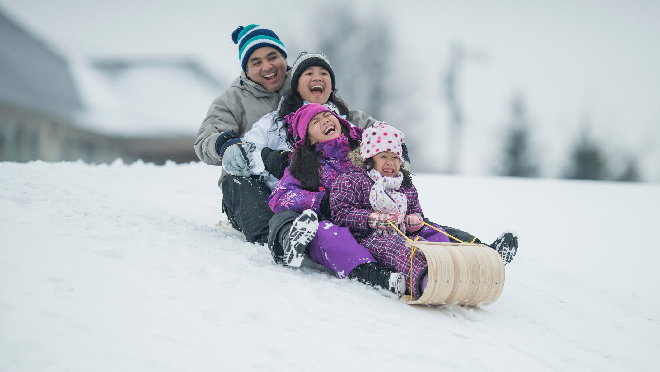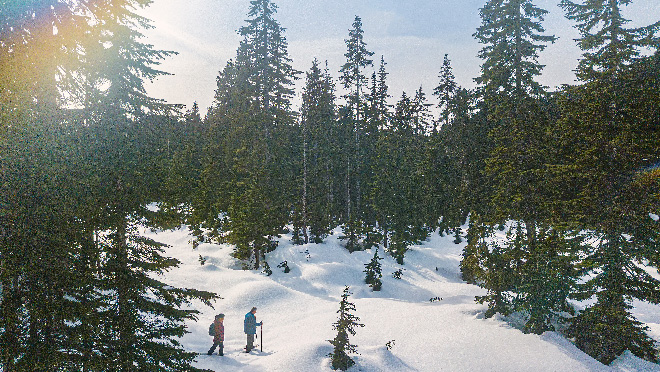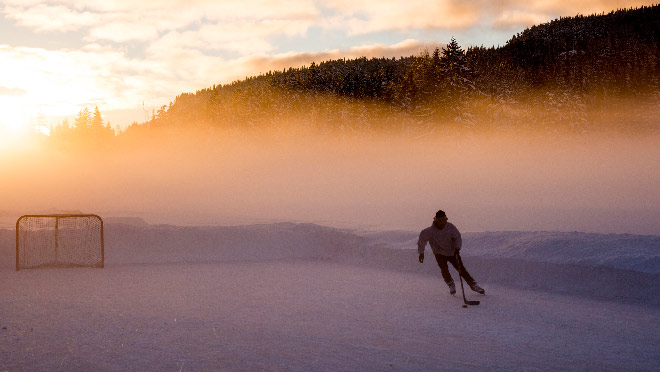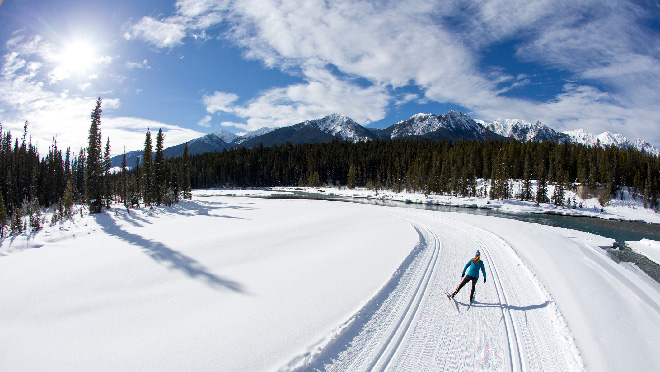The brr-illiant history behind these cool winter activities

Many pursuits have Indigenous roots, while others are from Europe
We're all thrilled the Vancouver Canucks are back in their hockey groove. But do you know where the idea of skating after an object, stick in hand, began? Or where tobogganing, ice fishing, skiing and snowshoeing got their starts?
To help celebrate the arrival of winter, we're looking back on how some of our favourite winter sports began, and to offer ideas and advice for doing it right (and doing it safely) here in B.C. So grab a hot chocolate, sneak a peek at the weather outlook, settle in.
At first, tobogganing wasn't exactly fun
Just as the Olympic sport of biathlon (skiing and shooting) began as a way to hunt and feed the family in winter, tobogganing was initially about survival, too. The word toboggan stems from the Algonquin family of languages, and initially had nothing to do with sliding down slopes for fun.
Historians think toboggans were first used by Indigenous peoples in what is now the Canadian north as far back 5,000 years ago. They were used to haul people or small loads over snow, and were pulled by dogs or people. That still happens in some places, but the snowmobile now dominates as the snow transport of choice.
Meanwhile, the toboggan lives on recreationally, and in many forms. While you can still buy vintage-style wooden toboggans and sleds, the go-to for fun on the hills are plastic saucers, carpets, and for those who seek speed and control, snow racer sleds equipped with snowmobile-style steering.
What you should know: Plastic sliders are inexpensive and fun, but they offer little or no control and won't last more than a few years – but they'll be around for hundreds of years in a landfill.
Tips and safety: There's lots of potential for big speed, which can be fun but also dangerous. Adults should check speeds and the safety of the slowdown area at the bottom (is there one?) before letting smaller kids down a hill. Outfit all kids with a helmet: ski and hockey helmets are best, but a bike helmet works in a pinch. Sliders with steering are safest. Always go feet first, in an area free of trees or other obstacles, and remove or carefully tuck in scarves and loose clothing that might catch on objects or other sleds.
Where to do it: Urban hills in the city, such as Little Mountain in Vancouver. Supervised sliding and tubing sites at ski mountains. Popular spots include Mount Washington (Vancouver Island), Big White (Kelowna), Apex (Penticton), Baldy (Oliver), Whistler-Blackcomb, Seymour, Grouse, and Cypress (Vancouver) and the Sea to Sky Gondola (Squamish).

Snowshoeing: practical and fun
Walking in boots through snow is slow. And if you're hunting game, the noise gives you away. Indigenous Peoples in the north figured out that strapping moccasins to 'snowshoes' made of animal skins or rawhide strung in frames of wood could solve both problems.
Historians believe snowshoes first arrived in North America during ancient migrations from eastern Siberia, over the Bering Strait, at least 10,000 years ago, but explorer Samuel de Champlain gave us our first written account of snowshoes in 1608. The world's first snowshoe club was formed in Montreal in 1840. Snowshoeing quickly became a popular recreational activity as well as a practical means of winter travel. Today, there are snowshoe races, including a world championship, along with races at both the Arctic Games and Canada Games.
What you should know: While it's tempting to jump at an online deal on snowshoes, do your homework or consult an in-store specialist. Designs and sizes vary considerably, and you'll want to consider the terrain (flat or hilly, soft and deeper snow or more packed), the weight of the person you're buying for, and whether you're buying them for treks or for running on snow. Consider renting or borrowing snowshoes at first to see what you like and what you might need.
Tips and safety: On hilly terrain, snowshoes with moderately grippy crampons (metal or plastic teeth under the toe of your boot) are a must.
Where to do it: B.C. is a wonderland for snowshoeing, and HelloBC gives recommendations for some epic adventures near Prince George, in the Rockies, and near Kamloops, On Vancouver Island, Mount Washington serves up 22 km of trails, and for the more adventurous, AllTrails has a list of trails that includes treks to the high alpine. Near Vancouver, Cypress, Seymour and Grouse all offer trails and rentals, and at gorgeous Callaghan Valley near Whistler, you can snowshoe to a frozen waterfall. Elsewhere in B.C., most downhill ski areas in B.C. feature trails and rentals.
Ice fishing for whitefish, perch and trout
Indigenous Peoples figured out long ago that using ice as a platform to access fish on lakes and rivers paid off. They used spears, hooks, and nets, and the practices live on. You can get a tremendous sense of how well net-fishing below ice (in Siberia) works in a section of the documentary Happy People: A Year in the Taiga on Prime or Apple TV.
Ice fishing with short rods and hooks, out in the open, or in huts, many of them wildly colourful and imaginative, is now a popular Canadian pastime.
What you should know: Go online for tips on gear, techniques and places to go in B.C., including the ice fishing tips page posted by the Freshwater Fisheries Society of B.C.
Tips and safety: Talk to locals about ice conditions, and ensure you have a valid freshwater fishing licence. Consider searching online for a guided ice fishing experience.
Where to do it: Local knowledge rules, and you can get some good tips about popular lakes in various regions, including the Thompson-Okanagan, where Sun Peaks Resort has a guided ice fishing option.

Ice hockey's roots are in ... the U.K.
Ice hockey as we know it was developed right here in Canada, but it was very much inspired by stick and ball games (bandy, hurling, shinty), played mainly in the British Isles in the 18th and 19th centuries. The first indoor hockey game was played in Montreal on March 3, 1875.
The actual number of registered hockey players in Canada has fallen since it hit a peak of over 700,000 in 2015, but there are still more than 500,000 registered players and many others who play outdoors or in drop-in sessions at local rinks. And while Canadians still lead the charge at the highest levels of play, it's now a truly international game with only 41% of current National Hockey League players from Canada.
The Vancouver Canucks count only seven Canadians on their extended 25-person roster, which features nine Americans, along with players from Sweden, Russia, Latvia, Switzerland, and Czechia.
What you should know: Used skates and other hockey equipment can be great options for the beginner (or for parents not looking to break the bank in equipping their kids). Whether you're buying or renting skates, know that skate sizing is usually about 1.5 sizes smaller than a shoe size. So if you have a size 8 runner, you could be a size 6.5 in a skate. A tight fit is what you're looking for.
Tips and safety: Wear a helmet, even if you're lucky enough to be skating on a frozen pond. And seriously consider elbow pads, as bruised elbows are common. If you think you're ready to join a league, start as a spare on several teams so that you can find the right level, and a fun group to socialize with, before you pay what can be very high fees for a full season of hockey.
Where to do it: Leagues and drop-in skating or hockey sessions at an arena near you. Or frozen ponds that are safe for skating. Consult the Life Saving Society of B.C. and Yukon for how to play safely on frozen lakes and ponds.

Scandinavians brought skiing to North America
While there seems to be some cave painting evidence in China and Russia that skiing began at least 7,000 years ago, the Sami of northern Scandinavia helped make it a more common practice. And we likely have the Norse to thank for introducing skiing to Canada, way back in about 1000 AD, to the point that today some of us are willing to pay up to $299 for a one-day lift pass at Whistler-Blackcomb.
What you should know: Alpine skiing (downhill) doesn't have to be expensive, and nordic skiing (cross-country) is generally quite affordable. Look for sales and used gear to get going, and consider learning at local hills or cross-country areas.
Tips and safety: Wear a helmet, ski and snowboard in-bounds, and learn safety etiquette. Dress for the weather.
Where to do it: Whistler-Blackcomb is one of the world's great downhill ski and snowboarding experiences, but there are many other wonderful places to ski in B.C. Some of the best options are in the Interior, where the snow is lighter and the lineups are generally short. You can downhill ski on Vancouver Island (Mount Washington, Mount Cain), in the Central Interior, and in or near the Rockies. And right on Vancouver's doorstep, Grouse, Seymour, and Cypress can be great options once the snow piles up. For cross-country ski options, go to cross-country BC's interactive map, where you'll find the links to the likes of Callaghan Valley, Cypress, Larch Hills, Stake Lake, Mount Washington, and Wells Gray Provincial Park.